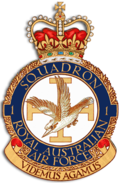No. 1 Squadron RAAF
| No. 1 Squadron RAAF | |
|---|---|

No. 1 Squadron's crest
|
|
| Active | 1916–19 1925–42 1943–46 1948–current |
| Country | Australia |
| Branch | Royal Australian Air Force |
| Role | Air-to-air/air-to-surface combat |
| Part of | No. 82 Wing |
| Garrison/HQ | RAAF Base Amberley |
| Nickname(s) | "Fighting First" |
| Motto(s) |
Videmus agamus (Latin: "We Seek and We Strike") |
| Engagements | World War I World War II Malayan Emergency Military intervention against ISIL |
| Battle honours |
Egypt 1915–1917 Palestine 1917–1918 Malaya 1948–1960 |
| Commanders | |
| Notable commanders |
Richard Williams (1917–18) Harry Cobby (1925–26) Raymond Brownell (1926–28) Frank Lukis (1930, 1932–34) Frank Bladin (1934–35) Alan Charlesworth (1936–39) Allan Walters (1940–41) Errol McCormack (1978–79) |
| Aircraft flown | |
| Attack | F/A-18F Super Hornet |
No. 1 Squadron is a Royal Australian Air Force (RAAF) squadron headquartered at RAAF Base Amberley, Queensland. Controlled by No. 82 Wing, it is equipped with Boeing F/A-18F Super Hornet multi-role fighters. The squadron was formed under the Australian Flying Corps in 1916 and saw action in the Sinai and Palestine Campaigns during World War I. It flew obsolete Royal Aircraft Factory B.E.2s, B.E.12s, Martinsyde G.100s and G.102s, as well as Airco DH.6s, Bristol Scouts and Nieuport 17s, before re-equipping with the R.E.8 in October 1917 and finally the Bristol Fighter in December. Its commanding officer in 1917–18 was Major Richard Williams, later known as the "Father of the RAAF". Disbanded in 1919, No. 1 Squadron was re-formed on paper as part of the RAAF in 1922, and re-established as an operational unit three years later.
During World War II, the squadron flew Lockheed Hudson bombers in the Malayan and Dutch East Indies campaigns, suffering severe losses before being reduced to cadre in 1942. It was re-formed with Bristol Beauforts the following year, and re-equipped with de Havilland Mosquitos in 1945 for further operations in the Dutch East Indies. Reduced to cadre once more after the war ended, No. 1 Squadron was re-established at Amberley in 1948 as an Avro Lincoln heavy bomber unit. From 1950 to 1958 it was based in Singapore, flying missions during the Malayan Emergency, where it bore the brunt of the Commonwealth air campaign against communist guerillas. When it returned to Australia it re-equipped with English Electric Canberra jet bombers. It operated McDonnell Douglas F-4E Phantoms from 1970 to 1973, as a stop-gap pending delivery of the General Dynamics F-111C swing-wing bomber. The F-111 remained in service for 37 years until replaced by the Super Hornet in 2010. From September 2014 to March 2015, a detachment of Super Hornets was deployed to the Middle East as part of Australia's contribution to the military intervention against ISIL.
...
Wikipedia
